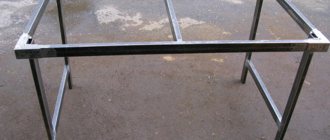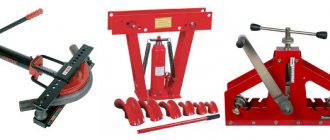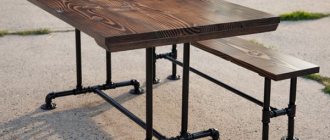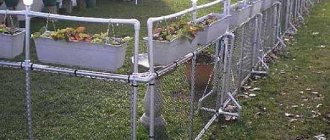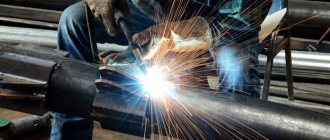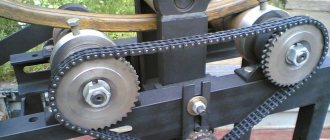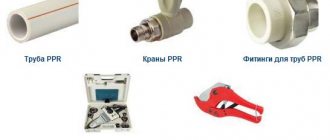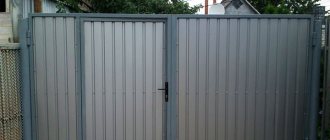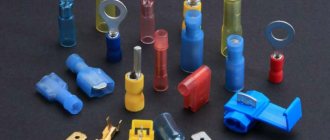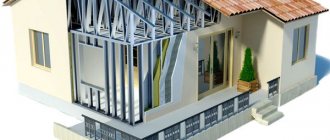A do-it-yourself polyethylene boat, a watercraft design with a 40...80 (hp) motor, capacity for up to four people, which is well suited for long tourist trips.
When developing design solutions, the well-known boat “Crimea” was taken as a basis, with modified sides surrounded by unsinkability blocks in the form of a half-pipe with a diameter of four hundred millimeters, under air pressure from 0.7 to 1.2 (atm.).
The presented boat consists of the following elements:
1…12 Frames. 13 Stem. 14 Keel beam. 15 Transom. 19 Upper deck rail. 21 Upper deck. 22 Board. 23 Bottom. 24 Half pipe.
The project includes:
- five assembly drawings
- thirty-one detail drawings
- specification on two sheets
- explanatory note on three sheets
The swimming vessel is made using conventional technology from low-density polyethylene sheet GOST 16338-85, grade 276, which has good ductility and flexibility and can be easily thermoformed.
The cockpit can accommodate two soft folding seats. The bows have two independent backrests that can be folded down to operate with oars. The aft seats fold down to create a nice bed.
The windshield frame for the boat is also made of sheet polyethylene. Plexiglas or transparent monolithic polycarbonate with a thickness of 3...5 (mm) is used as a transparent protective element, which is attached to the frame with matte aluminum plates using self-tapping screws.
Inside the hull, you can equip various compartments for storing fuel, all kinds of things and supplies.
There are three handles attached to the body, one at the front and two at the back, and two oars.
Source: chertegnik.ru
From the experience of manufacturing polyethylene boats
Domestic factories produce polyethylene sheets with maximum dimensions of 5X1450XX3200 mm, and the working dimensions of the table of existing vacuum forming machines do not exceed 1400X 3000 mm; this limited the dimensions of boats designed specifically to test the possibility of their mass production from domestic polyethylene. How the contours were chosen and what the Avtomobilist boat obtained as a result of our experimental work was described in detail in the article published in No. 46 of the collection. Let us only add that during the development of the project, special attention was paid to ensuring the rigidity of the fastening points of the sub-keys, towing eye and cleats as the most stressed sections of the structure. (It is known that high-density low-density polyethylene in a stressed state ages 1/3 faster than in a free state.)
Now let's talk about what the technological process for manufacturing the Avtomobilist polyethylene boat is. This process consists of three main stages:
- the actual molding of two sections;
- production of foam block filler;
- boat assembly and welding.
Technological equipment - the punches of the outer and inner shells were made of fiberglass. The sections were formed from thermoplastic sheets using a Universal DSU-200 vacuum forming machine. This machine has horizontal electric heaters that allow for double-sided pulse heating of the workpiece sheet. The required temperature regime is achieved by turning on a certain number of elements of both heaters. Additional adjustment of the upper heater allows you to more finely regulate the heating over the workpiece area, strengthening or weakening it in individual areas. This makes it possible to select the most rational heating mode for the sheet, which in thermoforming is one of the most important factors determining the quality of the product.
The polyethylene sheet, cleared of dust and dirt, was fed onto the clamping frame of the vacuum forming machine (the work table with the punch attached to it was in the lowest position), the frame was lowered and the sheet was clamped around the perimeter with compressed air (pressure 5-6 kg/cm2) . The upper and lower heaters were supplied, and the sheet was heated to the molding temperature. The temperature of the clamping frame was 50-70°C, the temperature of the equipment reached 50-60°C.
After heating the workpiece, the heaters were removed, compressed air at a pressure of 5 to 6 kg/cm 2 was supplied under the heated sheet, and the workpiece was raised approximately to the height of the punch, taking the shape of a bell; This ensured relatively uniform pre-stretching over the entire area of the workpiece.
Then a table with a punch was fed from below under the “bell”, the heated workpiece began to fit around the punch. To obtain full compliance of the product with the shape of the punch, a vacuum was created in the cavity between the sheet and the punch (from 0.6 to 0.9 kg/cm 2 ). The molded product was cooled to a temperature of 40° C, after which it was removed from the punch. The full molding cycle was 45 minutes.
The basic patterns of thickness distribution established during the work indicate that the highest quality material distribution is ensured by equipment that has a minimum of vertical sections. The elongation coefficient of the thermoplastic material of the boat’s hull structures is quite high: from 0.7 to 0.75. This circumstance imposes one of the main requirements for products designed for production using the vacuum forming method: the ratio of the depth (height) of the product (or a section of a local recess) to its width should not exceed one, otherwise during molding there will be an unacceptable decrease in the thickness of the material in vertical sections. For the same reason, all mating radii of two surfaces of the product must be more than 5 mm, three planes - at least 40 mm.
The molded sections were cut around the perimeter, after which a rigid filler block cast from PSB foam plastic was installed in the interbody space.
Technically, welding the connection of the outer and inner shells along the gunwale turned out to be a rather difficult operation. In our case, contact-press thermal welding was used.
A plate heated by an electric coil to 300° C was used as a coolant, which was placed between the surfaces to be welded. With the help of such plates, the welded surfaces were heated to 140° C in 20 seconds, and already at a distance of a few millimeters from the welding zone the material was at ambient temperature. The prepress pressure was 1.5–2 kg/cm2.
It can be argued that the vacuum molding method used in the manufacture of a small pilot batch of Avtomobilist boats is promising due to the possibilities of automating the technological process, the relatively low cost of equipment and the simplicity of equipment.
As foreign experience suggests, in order to increase the productivity of equipment and, in particular, reduce the time spent on heating the workpiece, it would be possible to make multi-position machines (carousel, rotary or in-line types). To further reduce costs, many companies find it advisable to equip production lines that include an extruder for producing sheets of the required size from granular raw materials, thermoforming machines, punching devices for cutting sections to a clean size and all the necessary devices for processing polyethylene waste.
Source: www.barque.ru
Brief instructions
- We make a detailed drawing indicating all parts of the product and dimensions.
- We transfer the dimensions of the boat parts in real form onto polypropylene sheets.
- We cut using a cutter or jigsaw, being careful, since at the beginning of cutting and at the end the tool can slip and cut through the material.
- At the junction of the individual parts we make a edging.
- We weld places where sealed joints are needed
- We fasten the necessary parts with bolts, stepping back from the edge by 10-15 mm.
- We install wooden seats, a transom for the motor, if necessary, and mounts for oars.
| For one traveler or fisherman, a homemade vessel can be made smaller |
Useful tips and tricks
- Some parts of the product can be connected not by bolts, but by welding, but in this case, repairing damaged areas will become impossible.
- It is not recommended to use even strong glue for fastening - there is a high probability of boat seams leaking.
- Drawings or diagrams of a polypropylene boat must be detailed, indicating the dimensions of parts of the bottom, sides and connecting points.
- Cut polypropylene sheets can be easily bent and reshaped without deformation.
- For the edging, it is advisable to cut recesses along the entire length of 3-4 mm.
- To use the motor upon completion of the work, you need to make a special transom out of wood.
Boats made of polyethylene
Does anyone have any considerations, thoughts, impressions, recommendations for assembling or operating polyethylene boats? Please share information
what is the topic about? Reef advertising?
There is no topic about boats made of a specific material. If you think that only RIF produces similar boats, then you are deeply mistaken. The most important thing about the material is that it has certain properties. There are plenty of boats like this in Russia. I would like to understand the positive and negative qualities of such buildings. I would like those who have experience in this area to share their impressions. WITHOUT BEING tied to the manufacturer, whether the boat was assembled by yourself or by someone else.
quote: Originally posted by vadim-kobozev: I would like to understand
quote: Originally posted by Filipok: so you don’t write anything. a set of photos, identical vessels that could fit into a couple of posts.
OK What exactly are your thoughts on the use of this material in this area? Do you have any experience in shipbuilding? I will be glad to know your position on this issue!
“Sew and glue” from sheet polyethylene.
“Sew and glue” from sheet polyethylene.
Message Investor » March 02, 2012, 15:00
Re: “Sew and glue” from sheet polyethylene.
Message Username » 02 Mar 2012, 16:24
Re: “Sew and glue” from sheet polyethylene.
Post by Gamil Zirak » March 03, 2012, 01:17
Re: “Sew and glue” from sheet polyethylene.
Post by Shoorick » 03 Mar 2012, 05:08
Re: “Sew and glue” from sheet polyethylene.
Post by Modest » 03 Mar 2012, 15:34
Re: “Sew and glue” from sheet polyethylene.
Post by Investor » March 04, 2012, 01:01
I typed in Yandex a polyethylene sheet - tons of offers. There really is a lot of it. As far as I understand, all sorts of containers for all kinds of liquids are welded from it. Kayak (boat), the same capacity, only in reverse.
Everything is the same as in the sew and glue technology, only instead of sewing, you weld and do not need to process it.
Source: forum.sea-kayak.ru
DIY boat made from PVC pipes
A do-it-yourself boat made from PVC pipes is a simple design. Its production will cost very little, but you can get a lot of pleasure during the summer swimming season. You can make such a structure from plastic materials yourself. It's not a difficult job.
PVC pipe is the most convenient option for constructing products with your own hands. These products are perfectly held together using glue or soldering.
Even if the boat gets damaged during use, there is no need to be upset. Such repairs on your own will not be difficult. Using the same glue, simply apply a patch to the damaged area.
To what has been said, it must be added that building such a boat with your own hands is a very interesting job.
It is recommended to start making a boat with the selection of a drawing. Based on them, the most convenient design is selected.
It’s a good idea to first make patterns of reduced sizes and glue such a structure from ordinary plastic bags. With this kind of work, you can “feel” the material, which means that working with full-scale sizes will be much easier.
After working out the patterns, they are increased proportionally. Craftsmen advise checking the compatibility of the workpieces by making the structure in natural dimensions from polyethylene.
This will, of course, take extra time, but it will be worth it. If any errors were made in the calculations, this will be clear at the initial stage, and there will be no need to spoil expensive materials.
Polypropylene
| Weight, kg): | 120 |
| Side height (cm): | 60 |
| Length(cm): | 375 |
| Max. load capacity (kg): | 300 |
| Max. motor power (l/s): | 15 |
| Material: | polypropylene |
| Passenger capacity: | 3 |
| Width(cm): | 148 |
The boat is intended for hunting, recreational fishing and boat trips on rivers, lakes and in coastal areas of reservoirs at a distance from the shore of no more than 1.6 km, with waves no more than 0.6 m high.
It differs from 370.01 in chrome plated cleats and handrails.
| Brand: | Technopolymer |
| Weight, kg): | 120 |
| Side height (cm): | 60 |
| Length(cm): | 375 |
| Max. load capacity (kg): | 300 |
| Max. motor power (l/s): | 15 |
| Material: | polypropylene |
| Passenger capacity: | 3 |
| Width(cm): | 148 |
| Brand: | Technopolymer |
| Weight, kg): | 280 |
| Side height (cm): | 73 |
| Length(cm): | 480 |
| Max. load capacity (kg): | 400 |
| Max. motor power (l/s): | 50 |
| Material: | polypropylene |
| Passenger capacity: | 4 |
| Width(cm): | 180 |
| Brand: | Technopolymer |
| Weight, kg): | 280 |
| Side height (cm): | 73 |
| Length(cm): | 490 |
| Max. load capacity (kg): | 450 |
| Max. motor power (l/s): | 60 |
| Material: | polypropylene |
| Passenger capacity: | 5 |
| Width(cm): | 180 |
Swimmer 450 is easy to control and easy to plan. Excellent for both fishing and family recreation. A boat of this size is very convenient for storage and transportation.
It differs from 450.01 mainly in better technical equipment.
| Brand: | Technopolymer |
| Weight, kg): | 280 |
| Side height (cm): | 73 |
| Length(cm): | 480 |
| Max. load capacity (kg): | 400 |
| Max. motor power (l/s): | 50 |
| Material: | polypropylene |
| Passenger capacity: | 4 |
| Width(cm): | 180 |
Swimmer 490 is easy to control and goes on planing easily. Excellent for both fishing and family recreation. A boat of this size is very convenient for storage and transportation.
The difference with 490.01 is better technical equipment.
| Brand: | Technopolymer |
| Weight, kg): | 280 |
| Side height (cm): | 73 |
| Length(cm): | 490 |
| Max. load capacity (kg): | 450 |
| Max. motor power (l/s): | 60 |
| Material: | polypropylene |
| Passenger capacity: | 5 |
| Width(cm): | 180 |
| Brand: | Technopolymer |
| Weight, kg): | 340 |
| Side height (cm): | 93 |
| Length(cm): | 550 |
| Max. load capacity (kg): | 500 |
| Max. motor power (l/s): | 90 |
| Material: | polypropylene |
| Passenger capacity: | 5 |
| Width(cm): | 227 |
Swimmer 550 is a light and easy-to-handle boat with a spacious cockpit for passengers and the captain. In the bow, the boat is equipped with a folding ladder for convenient boarding of passengers from an unequipped shore.
It stands out against the background of 550.01 due to its improved technical filling.
| Brand: | Technopolymer |
| Weight, kg): | 340 |
| Side height (cm): | 93 |
| Length(cm): | 550 |
| Max. load capacity (kg): | 500 |
| Max. motor power (l/s): | 90 |
| Material: | polypropylene |
| Passenger capacity: | 5 |
| Width(cm): | 227 |
Polypropylene is a very strong yet lightweight polymer material that offers an innovative weight-to-strength ratio. This level of strength allows the vessel to be unpretentious to operating conditions (for example, mooring to any shore or pier without fear of being left without sides or bottom), unpretentious to storage conditions and maintenance.
You can learn more about the manufacturing technology of the boats presented in this section here.
Boat made of plastic pipes
A homemade boat made from PVC pipes confidently takes a leading place among do-it-yourself crafts made from this material.
A home craftsman can turn the most ordinary plumbing workpiece into an original watercraft on his own.
- Frame. PVC blanks with a volume of at least 2.7 cm are cut into four parts. Two two meters and a half (for the upper part), and two with dimensions of 2.7 m (for the lower part). These pipes will serve as the load-bearing part of the structure.
- Each end part of these blanks should be cut at an angle of 45 degrees.
- Next, prepare slightly smaller trimmings with the following dimensions: 2 x 0.7 m, two x 0.6 m, two x 0.4 m and two x 0.35 m. These parts become supports for the boat frame.
- The support pipes are attached to the frame. The ends of the workpieces must be fastened tightly, otherwise everything will fall apart and go to the bottom. For fastening, you can use adhesive tape or epoxy glue. For reliability, you can drill holes in the tubes with a drill and secure the structure with copper wire.
- A wooden board with holes is prepared and secured to the bottom of the support frame. Plastic ties are used for fastening. The same fastenings are used to attach the chair to this board.
- After this, the frame is covered with tarpaulin. It must be waterproof. It is laid diagonally, and all protruding places are wrapped inside. The tarpaulin is secured to the frame with plastic clips. If the tarpaulin has rings, then you can attach it to the frame after holes have been made in it for this. All folds must be stretched as much as possible. This will prevent unnecessary resistance while moving through the water.
A PVC boat pipe keel serves to provide the craft with increased stability. Most often, the keel is installed on options using an outboard boat engine.
The keel is installed so that its working part is located in the bow area of the craft. From amidships to the stern the keel goes to "no".
Another advantage of installing a keel is that it partially raises the bow of the structure. And this, in turn, prevents splashes from entering the boat during large waves.
Vessel size calculation
The diameter of the floats, as well as the width and length of the vessel, depend primarily on where and how it will be used. The larger the crew expected and the more cargo will be transported, the larger the size of the craft and the diameter of the floats should be.
The carrying capacity of a vessel can be increased by increasing the cross-section of the cylinders or their length. The decisive factor in this situation is the volume of air inside the cylinders.
Optimal parameters for calculating floats,
Based on the crew and carrying capacity the following:
- a single-seat catamaran should have a length of 2-3 meters with a cylinder cross-section of 0.3-0.4 meters;
- for the manufacture of a two-seater vessel, cylinders with a length of 3.5-4 meters and a diameter of 0.45-0.5 meters are used;
- three and four-seater watercraft have a length of up to 6 meters with a float diameter of 0.5-0.6 meters.
It is not recommended to make a catamaran longer than 6 meters, since it will almost completely lose its maneuverability. Although, if you are going to sail mainly in a straight line, there are no restrictions on the size of such a “ship”.
The larger the size of the vessel, the greater its maneuverability and stability, but the less maneuverability. This applies to both its length and width.
The width of a catamaran is primarily determined by its purpose and method of propulsion. If you are making a catamaran for river rafting using the kayak principle, its width should not exceed 1.2 meters. Otherwise, capturing water with oars becomes impossible. If it is planned to board rowers on cylinders, the width of the vessel can be increased to 2 meters.
If the catamaran is a fishing or pleasure boat and it is planned to be equipped with a sail, motor or blades with pedals, its width can be increased further.
The width of the catamaran should be at least one and a half times less than its length.
Manufacturing procedure
To make a catamaran with your own hands, you need to decide on its purpose and, based on this, calculate the dimensions.
We will consider two options for the vessel: the simplest single-seater and a tourist raft based on a catamaran.
Single catamaran
We start making the simplest single-seat catamaran by making floats. We take two pipes of the same diameter and length (based on the calculations given above, we will need plastic pipes for external sewage with a diameter of 0.4 meters and a length of 2 meters). We fix it on one side of both pipes. This will be the back of the catamaran.
The front part needs to be raised for greater cross-country ability and maneuverability. To do this, we use two plastic elbows with a 120 degree bend. We attach them to the other end of the pipes and also close them with plugs.
When assembling cylinders, pay special attention to the tightness of the joints. The slightest depressurization can lead to the sinking of a ship on the water.
The floats are ready. You can start assembling.
To connect the floats into one “whole” catamaran, you can use anything. Plastic pipes of small diameter are suitable,
wooden blocks, metal corners, etc.
- From the material you choose, we make crossbars 1.2 meters wide.
- We install the cylinders strictly parallel to each other so that the bends point up and in the same direction.
- We fix the transverse strips on top of the cylinders. For fastening, both clamps and self-tapping screws can be used, with which the transverse strips can be screwed to the floats for greater strength.
- We install any comfortable seat on the cross beams, take the oars in our hands and row where we want.
Do-it-yourself single-seat catamaran made of plastic pipes (video)
Tourist raft
The basic principles of making these two watercraft with your own hands are not particularly different. The only difference is that the pleasure raft will obviously not be designed for one person.
And it’s even better if it can also accommodate cargo in the form of provisions, a sun umbrella, clothes, dishes, and other things.
- We make floats using the above method. But you should take a pipe with a diameter of 500-600 mm and a length of 6 meters. This will make it possible to create a stable and passable vessel on which you can take a nap without worrying about the life of the crew.
- We make a strong frame measuring 6*2 meters. Since the frame must not only hold the cylinders in the correct position, but also serve as a platform for the deck, it is better to make it from metal corners.
- Clamps are tightened onto the pipes from which the floats are made, to which, in turn, the frame is attached using bolts.
- Flooring is made from boards on the frame.
This design allows you to install any driving device on the catamaran, from blades driven by pedals to gasoline engines.
In addition, such a platform allows you to fully sunbathe in the sun, catch fish, and, in general, have a fun and fruitful relaxation in a narrow circle of best friends.
In the modern world, DIYers have a lot of inexpensive materials from which they can make a boat with their own hands.
In this article we will look at how to make a homemade boat from PVC pipes.
The easiest way to make a boat from PVC pipes is to assemble the frame of a homemade floating craft using tape and stretch plastic film on top.
This method of assembling a boat with your own hands is very simple and does not require any tools, except perhaps a knife or saw for cutting plastic pipes to size.
Watch a video of making a homemade boat from plastic pipes and film.
As you can see, there are practically no difficulties!
Here's a test of this boat afloat.
It must be said that the not very adequate sailing qualities of this homemade boat lie entirely on the handiwork of the assemblers.
In fact, all homemade boats using this technology have lawyer Egorov’s kayak in their prototype.
Only he took the production seriously and the result was much better. It all depends on you!
You don’t need to wrap a homemade boat with film, but use banner fabric. This will avoid leakage, and the strength characteristics of covering the boat with banner fabric will increase by an order of magnitude.
Making the keel
A homemade keel for a boat from a plastic pipe is easy to do. All the material that goes into work is durable, light weight and low cost. This keel is ideal for a punt.
For production, a four-part plastic profile is taken, which is used in assembling windows and window sills. It is covered with two foam rubber sleeves, which are used to insulate pipe materials.
Next, the keel is wrapped in packaging film, which is laid in several layers. In the areas where the keel is attached, wide tape is wound.
For convenience, the keel is cut in half and, when connected, a PVC pipe (approximately 0.5 m in size) is inserted into the middle of the tetrahedron.
A keel made of such materials does not get wet, does not emit toxic substances, and is not destroyed by exposure to the rays of the sun.
You can also make a homemade floor (slan) for flat-bottomed boat structures. For work you will need four boards, approximately 0.9 cm thick.
The width of all pieces should be equal to the distance from the side parts of the structure. All these pieces are held together with tightening plastic clamps.
The boat frame made of PVC pipe is the basis of the basics. The integrity of the structure will depend on its strength. You can learn how to build a frame correctly in the videos provided.
If you approach this issue irresponsibly, the constructed structure will fall apart the first time you try to launch it into the open water.
After detailed development and verification of the drawing, practical work on creating the frame can begin. You can secure the frame using the methods already suggested above, or you can use a soldering iron for plastic products.
Working with such tools is not difficult. Even a person who has no experience in this field can cope with these works. Soldering irons come with instructions that describe the entire procedure in detail.
It is not recommended to buy this tool for a one-time job to weld a frame, justifying it as economically unprofitable.
It is better to use a rented device to attach a frame made of plastic pipes. This service is offered by stores that sell soldering irons.
A frame made from blanks soldered with a soldering iron will last a long time. In this case, each joint of the frame will be highly durable. This way you can make a very durable structure with your own hands.
If any difficulties arise during work, video materials will help you solve the problem of how to properly make a frame from PVC pipes.
Unlike a boat, which will take a little time to create, a boat cart made from PVC pipes can be made quickly. It is intended for transporting a boat made of PVC pipes with an engine and adjacent cargo.
The presence of a trolley makes transporting the boat much easier. Having a do-it-yourself trolley, you can do the transportation without any outside help or stress.
In the provided photos and videos, you can see various options for these mechanisms. After considering them, you can choose the most suitable option for building with your own hands.
Video The dimensions of the cart depend on the dimensions of the boat. And when calculating them, you need to keep in mind that the width of the cart should be such that the watercraft fits comfortably on it.
To create such a design with your own hands, you need to prepare a pipe with a volume of 32 mm. Experts recommend choosing products reinforced with fiberglass.
You should also stock up on appropriate fasteners for the pipes (couplings and crosses). You will also need a pair of wheels and a steel rod.
First, an axle is made from tubes with an inserted steel rod. Wheels are inserted onto it and secured with brackets. Next, a frame is made from the tubes, which is placed on supports above the axle.
On the frame it is necessary to provide fastenings for a rope with which the floating device will be secured to the trolley. That, in fact, is all the work.
Some more details
Now it’s clear how to make a boat from PVC pipes. This work will require a lot of patience and will take quite a bit of time, but in the end result you can get great pleasure from such an addition to your vacation on the water as an excellent boat made by yourself.
For ease of swimming you will need oars. They are also not difficult to make with your own hands. A thin PVC pipe is perfect for this.
It will need about two meters. Holes must be drilled at each end of the pipe roll. Then two strips 0.4 m long are cut out of acrylic.
These strips are attached to plastic tubes with self-tapping screws. It is not recommended to tighten the screws very tightly, because the acrylic may burst. It is recommended that the lower part of the oar be slightly rounded.
Watch the video
There are advantages to this addition, such as the creation of free space for storing catch or any other small items. But this solution also has its downsides; it is a little more difficult to row on such swimming structures due to lack of space.
A real fisherman does not give up fishing either in winter or in bad weather. When fishing in the summer, an awning can protect you from the scorching rays of the sun and from pouring rain while afloat. With such protection, the river trip will not be hopelessly ruined.
Buying such an awning is not a cheap pleasure, so many fishermen equip their “submarines” with awnings that they make with their own hands.
The simplest design is an awning, which is mounted on a frame mounted on posts. All this can be made from PVC pipes.
The work is done like this: a tarpaulin or PVC fabric is attached to the frame at the end. PVC pipes are a lightweight material that will not take on overall weight.
At the same time, they are quite strong, and the frame will not break if it accidentally gets caught with branches or bushes hanging over the water.
The design of a do-it-yourself awning made from PVC pipes can be very different; it all depends on the size and shape of the product, and on personal preferences.
A boat made from PVC pipes with your own hands will become unique if you decorate it further. Many people pay special attention to this point, for example, they paint it with acrylic paints, cover it with painted sheets of plywood, and more.
Video After such events, a creation constructed with your own hands will definitely be unique and memorable. The entire design will not require a large amount of finance, because store-bought analogues are much more expensive.
A little patience and perseverance spent in the design process will bring great pleasure from relaxing on the river.
Why a catamaran?
There are a lot of options for watercraft, as well as their purposes. For those who live near bodies of water, and especially for those for whom overcoming a water obstacle is a vital necessity, a catamaran is ideal. This type of vessel has many advantages.
in front of kayaks, boats or yachts.
- To make catamarans from plastic pipes, a minimum amount of material is required. In addition, remnants from the recent installation of a sewer or water supply system may well be used;
- the catamaran is light in weight, so it does not cause problems in terms of transportation;
- due to the design features - two cylinders connected by a deck, such a craft has high seaworthiness, strength, reliability and sufficient speed;
- the ability to accommodate the required number of seats;
- Any type of engine can be installed on a catamaran.
What does a catamaran consist of?
The catamaran has a large number of design features compared to other watercraft.
That is why you need to know its components in detail,
before starting drawings and installation work.
- The first, and most important, part of the catamaran is the floats. These are two chamber structures located on the sides of the craft. Their immediate task is to keep the ship afloat. Cylinders can be made of different materials that limit the outer perimeter of the float. To do this, use the film from which inflatable cylinders, foam plastic or PVC pipes are made.
- Connecting frame. It can be made of any materials, from the same plastic pipes to wood or metal. The lighter the catamaran frame, the smaller the floats can be.
- Deck. This part is created to accommodate passengers, luggage and other things that will be transported by water.
- Steering wheel. The function of the rudder of any watercraft is performed by an underwater blade, which for movement is directly installed parallel to the movement, and for turning it is bent in one direction or another using a rotary handle brought to the deck.
- Oars, pedals, motor or any other device that propels the catamaran.
